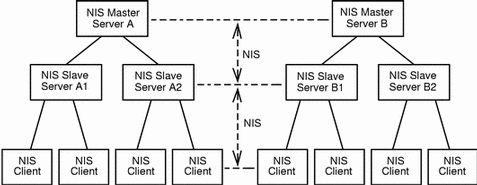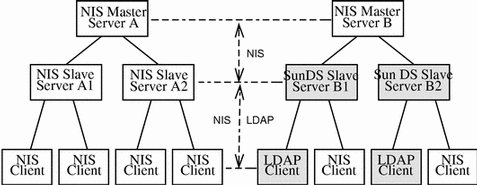Migrating from NIS to Sun Directory Services
The NIS server provided with the Sun Directory Services overcomes some of the limitations of a classic NIS naming service, namely:
-
A classic NIS server propagates whole tables, not just updates
-
A classic NIS server cannot handle very large tables, that is, tables that hold over 50,000 to 60,000 entries
If you have a well established NIS environment, the best way to manage the transition without disrupting your naming service is outlined below in Figure 6-1, Figure 6-2 and Figure 6-3.
Figure 6-1 shows a pure NIS environment with NIS requests from clients handled by the closest NIS server on the network. The synchronization of information held on master and slave servers is handled through NIS propagation of tables.
Figure 6-1 Pure NIS Environment

Figure 6-2 shows a progressive replacement of NIS slave servers by Sun Directory servers. Replacing slave servers before master servers is the recommended approach because the change will affect just some clients and not the entire network. This gives you the opportunity to adapt your procedures to the new tools. You can then apply these procedures when you do decide to migrate your NIS master servers to Sun Directory Services.
At this stage, your local slave servers also support LDAP clients. You must still use NIS for replication.
Figure 6-2 Mixed NIS - Sun Directory Services Environment

Figure 6-3 shows an environment where all legacy NIS servers have been replaced by Sun Directory Servers. Your servers support both NIS and LDAP requests, and you should use LDAP replication between master servers and slave servers.
Figure 6-3 Sun Directory Services Environment

- © 2010, Oracle Corporation and/or its affiliates
